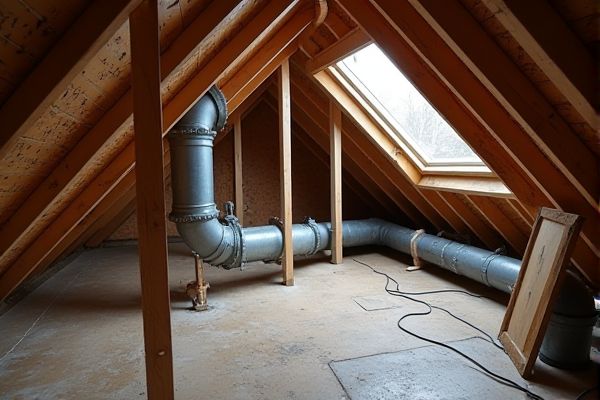
Exposed attic pipes offer easy access for maintenance and inspections, reducing the risk of unnoticed leaks or damage. Understanding the pros and cons of exposed versus hidden utilities will help you make the best decision for Your home's efficiency and aesthetics--read on to explore these options in detail.
Table of Comparison
| Feature | Attic Exposed Pipe | Hidden Utilities |
|---|---|---|
| Installation Cost | Lower; easy access reduces labor | Higher; requires wall or ceiling modification |
| Maintenance Access | Easy; visible and reachable for repairs | Difficult; requires opening walls or ceilings |
| Durability | Exposed to temperature changes; may need insulation | Protected from environmental exposure |
| Aesthetic Impact | Visible pipes may be less visually appealing | Hidden from view; cleaner look |
| Risk of Damage | Higher; susceptible to physical damage | Lower; shielded by building structure |
| Energy Efficiency | Potential heat loss if uninsulated | Better insulation integrated, improving efficiency |
Understanding Attic Utilities: Exposed Pipes vs Hidden Systems
Exposed pipes in attics enable easier inspection and maintenance, reducing potential issues like leaks and insulation problems. Hidden attic utilities, including plumbing and HVAC systems, offer a cleaner aesthetic but complicate access for repairs and increase the risk of unnoticed damage. Choosing between exposed pipes versus hidden systems depends on factors like ease of maintenance, insulation efficiency, and potential impact on attic ventilation.
Pros and Cons of Exposed Attic Pipes
Exposed attic pipes allow for easy access during maintenance and quick leak detection, reducing repair time and costs. However, they are more vulnerable to temperature fluctuations, which can lead to freezing or condensation issues, and may reduce attic space aesthetics. Conversely, hidden utilities provide protection and a cleaner look but complicate repairs and inspections, potentially increasing labor expenses.
Advantages of Concealed Utilities in Attic Spaces
Concealed utilities in attic spaces improve aesthetic appeal by hiding unsightly pipes and wiring, creating a cleaner and more organized appearance. These hidden installations reduce the risk of accidental damage and enhance safety by limiting exposure to heat, moisture, or physical impacts. Improved insulation efficiency and reduced heat loss are additional benefits, contributing to energy savings and optimal system performance.
Safety Considerations: Exposed vs Hidden Attic Pipes
Exposed attic pipes offer easier access for regular inspections and maintenance, reducing the risk of unnoticed leaks or damage that could compromise your home's safety. Hidden utilities, while aesthetically cleaner, may increase hazards such as mold growth or structural deterioration due to delayed detection of issues. Ensuring proper installation and periodic checks of either exposed or concealed pipes is essential for maintaining attic safety and preventing costly repairs.
Energy Efficiency Impact: Open vs Hidden Utility Lines
Exposed attic pipes often lead to greater heat loss or gain, reducing overall energy efficiency due to direct exposure to fluctuating attic temperatures. In contrast, hidden utility lines insulated within walls or ducts maintain more stable temperatures, minimizing thermal exchange and improving HVAC system performance. Proper insulation of any attic pipes, whether exposed or hidden, is critical to maximizing energy savings and maintaining consistent indoor climate control.
Maintenance and Accessibility: Choosing the Best Option
Exposed attic pipes offer superior maintenance access, simplifying inspections and repairs while reducing the likelihood of hidden leaks or damage. Hidden utilities, although aesthetically pleasing, complicate maintenance efforts by requiring ceiling or wall openings, increasing repair time and costs. Prioritizing exposed piping in attics enhances long-term system reliability and minimizes maintenance challenges.
Aesthetic Implications: Visible Pipes vs Hidden Utilities
Exposed attic pipes create an industrial aesthetic that can enhance modern or rustic designs by adding texture and visual interest. Hidden utilities offer a cleaner, streamlined appearance that maintains architectural integrity and minimizes visual clutter. Choosing between exposed or concealed pipes depends on your preference for either functional display or polished concealment in your attic space.
Cost Analysis: Exposed Pipes vs Concealed Utilities
Exposed attic pipes generally incur lower installation and maintenance costs due to easier access for repairs and inspections, reducing labor fees and downtime. Concealed utilities require additional materials like drywall, insulation, and finishing, escalating both initial construction expenses and potential repair costs as hidden systems complicate troubleshooting. Budget considerations should weigh long-term maintenance savings against upfront costs, with exposed piping favored for cost efficiency and concealed utilities chosen for aesthetic and noise reduction benefits.
Impact on Property Value and Resale Potential
Exposed attic pipes can decrease property value due to aesthetic concerns and perceived maintenance issues, making homes less attractive to potential buyers. Hidden utilities improve visual appeal and convey a well-finished space, enhancing resale potential by aligning with buyer preferences for clean, unobstructed designs. Your choice to conceal utilities can contribute positively to the marketability and overall appraisal of your property.
Best Practices for Attic Plumbing and Electrical Utilities
Attic plumbing and electrical utilities require careful consideration to prevent damage and ensure efficient maintenance. Best practices include using insulated, accessible pipe routes to reduce freezing risk and facilitate repairs, while electrical wiring should be secured with protective conduit to avoid physical damage and comply with building codes. Proper ventilation and regular inspections in the attic space help maintain system integrity and prevent moisture-related issues affecting both plumbing and electrical components.
 homyna.com
homyna.com